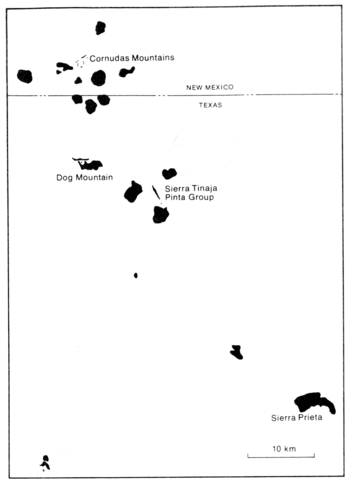stripes
The northernmost part of the Trans-Pecos magmatic province constitutes the Diablo Plateau including the Cornudas Mountains. All the igneous rocks are intrusive and emplaced either in Permian or Cretaceous sedimentary rocks. Twenty two individual intrusions are listed by Barker et al. (1977, Table 1) which occupy a total area of 44 km2. A detailed map of part of the central Sierra Tinaja Pinta group is given by Barker (1974, Fig. 4) and of Wind Mountain by Warner et al. (1959, Fig. 38). Eight of the intrusions are discordant sheets, five are sills, four plugs, one a cone sheet, two laccoliths and two domes or possibly laccoliths. Other intrusions have been encountered in boreholes, and dome structures in Lower Permian limestones probably lie above intrusive bodies. Deep seated xenoliths are generally small but cognate inclusions are more abundant; fenitized xenoliths containing a pale blue amphibole have been found. Contact metamorphism is widespread with the production of varied calcsilicate assemblages and hornfelses. Variation of rock types within the area is not particularly marked extending from nepheline syenite and phonolite to slightly oversaturated syenite and trachyte; nine rock types are distinguished by Barker et al., (1977). Syenites and trachytes vary from types with a little nepheline and analcime to quartz-bearing varieties; the mafic minerals include altered olivine, augite, kaersutite and biotite. Nepheline syenites and phonolites comprise anorthoclase and perthite, interstitial to euhedral nepheline, variably replaced by analcime or sodalite, fayalite, often mantled by amphibole or pyroxene, amphiboles including arfvedsonite, riebeckite and hornblende, clinopyroxene, biotite and accessories including a little aenigmatite, eudialyte, catapleiie and bastnaesite in some rocks. Numerous chemical analyses and modes are available as supplementary material to the paper by Barker et al. (1977, footnote p. 1438) and mineral data to the mineralogical account of Barker and Hodges (1977, footnote p. 1429).
BARKER, D.S. 1974. Alkaline rocks of North America. In H. Sorensen (ed.). The Alkaline Rocks. John Wiley, London: 160-71.
BARKER, D.S. and HODGES, F.N. 1977. Mineralogy of intrusions in the Diablo Plateau, northern Trans-Pecos magmatic province, Texas and New Mexico. Bulletin of the Geological Society of America, 88: 1428-36.
BARKER, D.S., LONG, L.E., HOOPS, G.K. and HODGES, F.N. 1977. Petrology and Rb-Sr isotope geochemistry of intrusions in the Diablo Plateau, northern Trans-Pecos magmatic province, Texas and New Mexico. Bulletin of the Geological Society of America, 88: 1437-46.
WARNER, L.A., HOLSER, W.T., WILMARTH, V.R. and CAMERON, E.N. 1959. Occurrence of nonpegmatite beryllium in the United States. Professional Paper, United States Geological Survey, 318: 1-198

